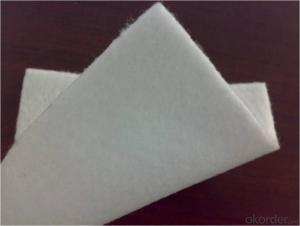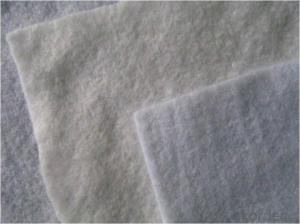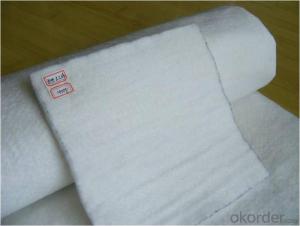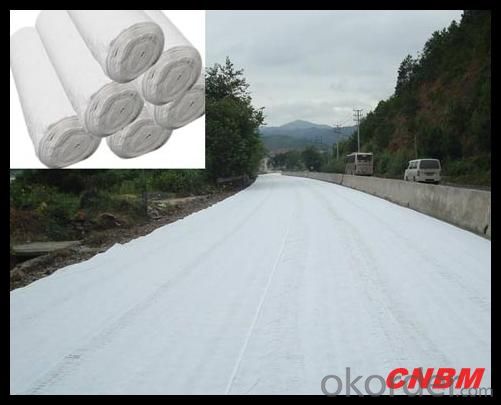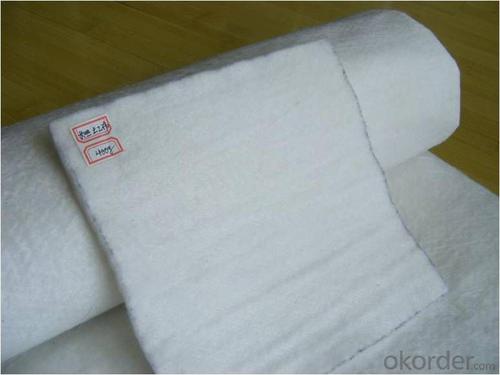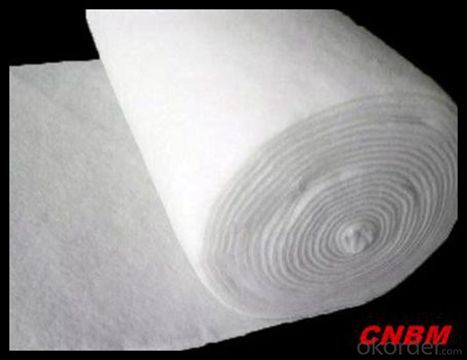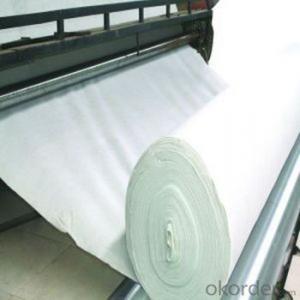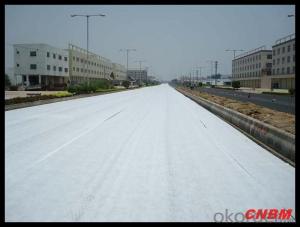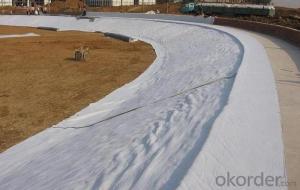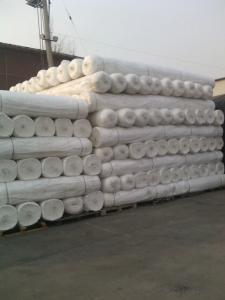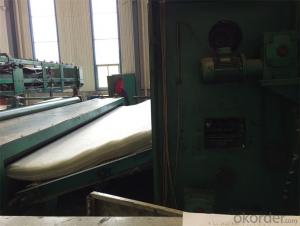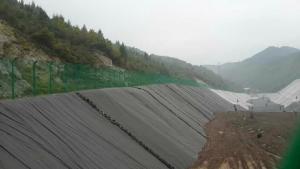Typar 3401 Geotextile - Polypropylene Nonwoven Geotextile Fabric Non-Woven Geotextile Price CNBM
- Loading Port:
- China main port
- Payment Terms:
- TT OR LC
- Min Order Qty:
- 1000 g/m²
- Supply Capability:
- 1000000 g/m²/month
OKorder Service Pledge
OKorder Financial Service
You Might Also Like
Specification
Product Features
|


Packaging & Shipping
Packing: PLASTIC FILM INSIDE, AND WOVEN BAG OUTSIDE
Shipping: About 15 days after receipt the deposit
Quality assurance
1.On a regular basis or as per your request,we entrust national testing agencies to conduct quality inspections
2. Strictly in accordance with the ISO9001-2008 international quality system standard,we monitor and manage the whole process throughout production,quality testing,and measurement to ensure product quality
3. For quality-related construction delay or substandard construction(except for damage or losses due to customer’s responsibility or irresistible natural disasters),we have refunding,replacement,and repair services.We will respond to customers’ feedbacks on quality issues within 24 hours.
After-sales service
1.In order to provide customers with comprehensive technical support,we will provide technical and other related information upon request in a timely manner.
2.In required,we will appoint specialized technicians to the construction site to give technical trainings to construction people,and offer technical guidance throughout the whole construction process.
3.For damage due to shipment and delivery,after we receive the complaint,we will check the issure through provided pictures and videos.If our responsibility is confirmed,we wil offer free replacement.
4.When the construction is completed,as your request,our technical staff may participate in the final acceptance.
FAQ:
Q: What kind of payments does jenor support?
A: T/T, L/C, Cash are accepted.
Q: Do you charge for the samples?
A: Accordeing to our company policy, the samples are free, we only charge the freight fee. And we will return the freight fee during the next order.
Q: Can you produce according to customers' design?
A: Sure, we are professional manufacturer, OEM and ODM are both welcome.
Q: Do you have other products?
A: Yes, please check the pictures:
- Q: Can geotextiles be used in geocomposite drains?
- Yes, geotextiles can be used in geocomposite drains. Geotextiles are often used as a filtration layer in geocomposite drains to prevent soil particles from clogging the drain and to allow water to pass through.
- Q: How do geotextiles help with filtration in stormwater management systems?
- Geotextiles help with filtration in stormwater management systems by providing a barrier that allows water to pass through while retaining sediment, silt, and other pollutants. They prevent the clogging of drainage systems, improve water quality, and help in the overall maintenance and effectiveness of stormwater management infrastructure.
- Q: Can geotextiles be used in railway construction?
- Yes, geotextiles can be used in railway construction. Geotextiles are often utilized in railway projects for various purposes such as soil stabilization, erosion control, filtration, drainage, and separation. They help improve the durability and performance of railway infrastructure by providing reinforcement, preventing soil movement, and enhancing drainage systems.
- Q: What is the consequence of the geotextile of the ground floor
- What are the consequences of what can not be finalized, the first roof of the waterproof layer and waterproof protective layer is very important, this is the first barrier, imagine, now many of the green plants are large trees, grow 10 years or even 20 years After the roots will be very developed, think about how the pine trees on the tenacious know their strength, coupled with long-term erosion by the water, the concrete layer will gradually lose its ideal performance, barrier layer and drainage board will certainly be better To protect the role and drainage. So to speak, long-term vision of the words must be solidly do every layer, only focus on economic interests and short-term effects, then, within a few years will not be any problem.
- Q: What are the different geotextile reinforcement techniques?
- Some of the different geotextile reinforcement techniques include geotextile fabrics, geogrids, geocells, and geocomposites. Geotextile fabrics are permeable fabrics made from synthetic materials and are used to stabilize soil and prevent erosion. Geogrids are high-strength materials that are used to enhance the stability of soil by providing tensile reinforcement. Geocells are three-dimensional honeycomb-like structures made from geotextile materials and are used for soil stabilization and erosion control. Geocomposites are combination products that consist of different geotextile materials and are used for various reinforcement applications, such as drainage, filtration, and separation.
- Q: How long do geotextiles last?
- Geotextiles can vary in lifespan depending on various factors such as the quality of the material, the specific application, and the environmental conditions they are exposed to. However, on average, geotextiles can last between 20 to 50 years.
- Q: Can geotextiles be used in underground storage tank installations?
- Yes, geotextiles can be used in underground storage tank installations. Geotextiles are commonly used as a protective barrier between the tank and the surrounding soil, providing filtration and separation functions. They can help prevent soil erosion, control groundwater flow, and provide additional stability to the tank system.
- Q: How do geotextiles interact with other geosynthetic materials?
- Geotextiles interact with other geosynthetic materials by complementing their functions and enhancing their performance. They can be used in conjunction with geogrids, geomembranes, or geocomposites to provide additional reinforcement, filtration, separation, or drainage capabilities. Geotextiles can be layered between different geosynthetic materials to create a composite system that addresses multiple engineering requirements in various civil and environmental applications.
- Q: How do geotextiles help in reducing the risk of soil liquefaction?
- Geotextiles help in reducing the risk of soil liquefaction by providing reinforcement and stabilization to the soil. When geotextiles are installed in areas prone to liquefaction, they act as a barrier between the layers of soil, preventing the movement and flow of water. This restricts the buildup of excess pore water pressure within the soil, which is a major factor in causing soil liquefaction. Additionally, geotextiles improve the overall strength and cohesion of the soil, making it less susceptible to liquefaction under seismic or water-induced loading.
- Q: Can geotextiles be used for reinforcement of road embankments?
- Yes, geotextiles can be used for reinforcement of road embankments. Geotextiles are commonly used in civil engineering projects to improve the stability and performance of road embankments. They can effectively distribute loads, increase soil shear strength, and prevent soil erosion, offering a reliable and cost-effective solution for road reinforcement.
Send your message to us
Typar 3401 Geotextile - Polypropylene Nonwoven Geotextile Fabric Non-Woven Geotextile Price CNBM
- Loading Port:
- China main port
- Payment Terms:
- TT OR LC
- Min Order Qty:
- 1000 g/m²
- Supply Capability:
- 1000000 g/m²/month
OKorder Service Pledge
OKorder Financial Service
Similar products
Hot products
Hot Searches
Related keywords
